Comprehensive Project Scope Management Report and Assessments
VerifiedAdded on 2020/06/04
|25
|6957
|46
Report
AI Summary
This comprehensive report delves into the intricacies of project scope management, encompassing formative and summative assessments. It begins by exploring the necessity of collecting requirements in scope management, considering authority, and understanding stakeholder expectations. The report then details the scope definition process, the importance of a Work Breakdown Structure (WBS), and the methods for scope verification. It covers scope control procedures, techniques for managing scope changes, and strategies for identifying scope management issues. The summative assessments address key components of a scope management plan, factors impacting scope, change control procedures, and methods for measuring work outcomes. It also defines scope creep and its impact, and the reporting process for scope changes. Finally, the report outlines the role of a project manager in collecting requirements and the aspects included in project initiation documents, offering a complete overview of the project scope management lifecycle.
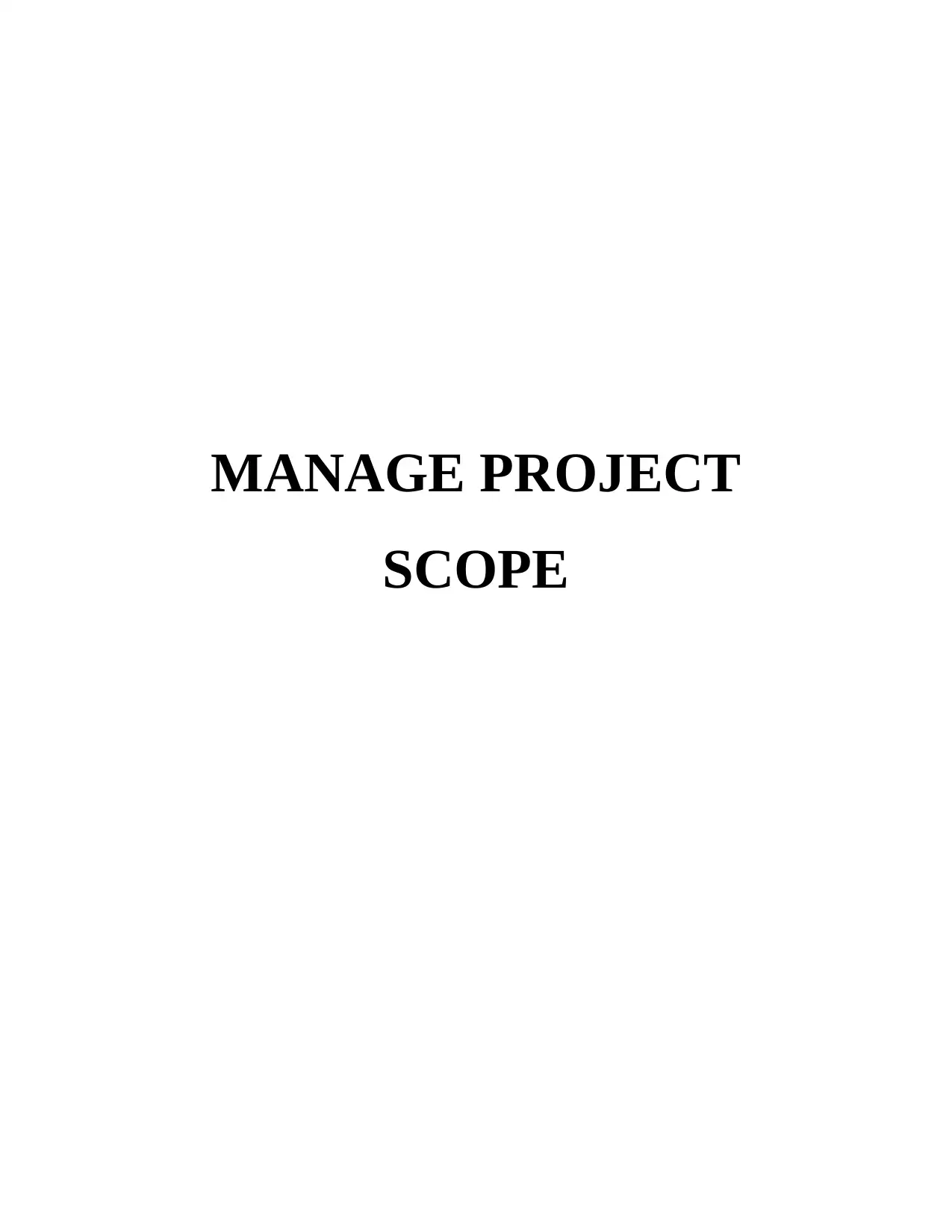
MANAGE PROJECT
SCOPE
SCOPE
Paraphrase This Document
Need a fresh take? Get an instant paraphrase of this document with our AI Paraphraser
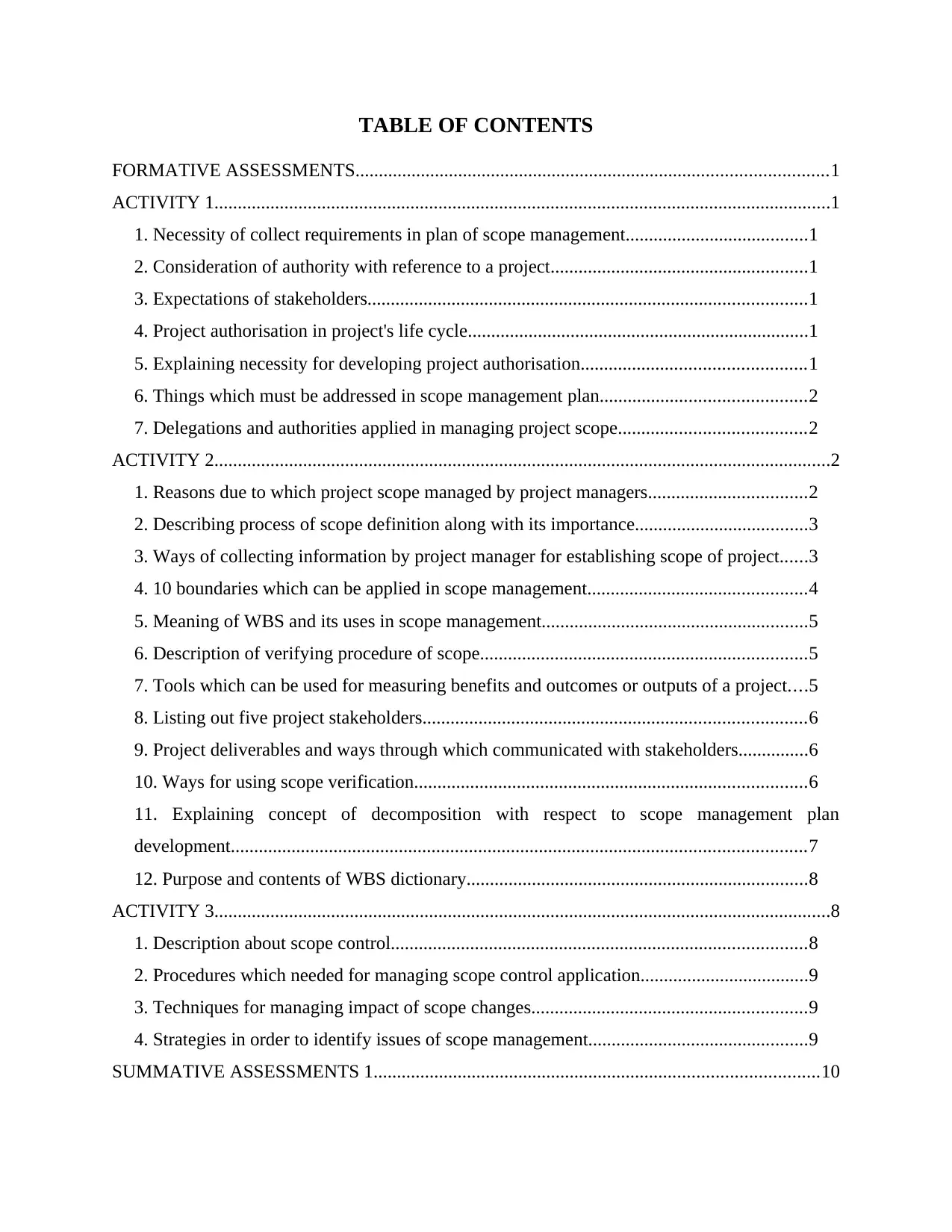
TABLE OF CONTENTS
FORMATIVE ASSESSMENTS.....................................................................................................1
ACTIVITY 1....................................................................................................................................1
1. Necessity of collect requirements in plan of scope management.......................................1
2. Consideration of authority with reference to a project.......................................................1
3. Expectations of stakeholders..............................................................................................1
4. Project authorisation in project's life cycle.........................................................................1
5. Explaining necessity for developing project authorisation................................................1
6. Things which must be addressed in scope management plan............................................2
7. Delegations and authorities applied in managing project scope........................................2
ACTIVITY 2....................................................................................................................................2
1. Reasons due to which project scope managed by project managers..................................2
2. Describing process of scope definition along with its importance.....................................3
3. Ways of collecting information by project manager for establishing scope of project......3
4. 10 boundaries which can be applied in scope management...............................................4
5. Meaning of WBS and its uses in scope management.........................................................5
6. Description of verifying procedure of scope......................................................................5
7. Tools which can be used for measuring benefits and outcomes or outputs of a project....5
8. Listing out five project stakeholders..................................................................................6
9. Project deliverables and ways through which communicated with stakeholders...............6
10. Ways for using scope verification....................................................................................6
11. Explaining concept of decomposition with respect to scope management plan
development...........................................................................................................................7
12. Purpose and contents of WBS dictionary.........................................................................8
ACTIVITY 3....................................................................................................................................8
1. Description about scope control.........................................................................................8
2. Procedures which needed for managing scope control application....................................9
3. Techniques for managing impact of scope changes...........................................................9
4. Strategies in order to identify issues of scope management...............................................9
SUMMATIVE ASSESSMENTS 1...............................................................................................10
FORMATIVE ASSESSMENTS.....................................................................................................1
ACTIVITY 1....................................................................................................................................1
1. Necessity of collect requirements in plan of scope management.......................................1
2. Consideration of authority with reference to a project.......................................................1
3. Expectations of stakeholders..............................................................................................1
4. Project authorisation in project's life cycle.........................................................................1
5. Explaining necessity for developing project authorisation................................................1
6. Things which must be addressed in scope management plan............................................2
7. Delegations and authorities applied in managing project scope........................................2
ACTIVITY 2....................................................................................................................................2
1. Reasons due to which project scope managed by project managers..................................2
2. Describing process of scope definition along with its importance.....................................3
3. Ways of collecting information by project manager for establishing scope of project......3
4. 10 boundaries which can be applied in scope management...............................................4
5. Meaning of WBS and its uses in scope management.........................................................5
6. Description of verifying procedure of scope......................................................................5
7. Tools which can be used for measuring benefits and outcomes or outputs of a project....5
8. Listing out five project stakeholders..................................................................................6
9. Project deliverables and ways through which communicated with stakeholders...............6
10. Ways for using scope verification....................................................................................6
11. Explaining concept of decomposition with respect to scope management plan
development...........................................................................................................................7
12. Purpose and contents of WBS dictionary.........................................................................8
ACTIVITY 3....................................................................................................................................8
1. Description about scope control.........................................................................................8
2. Procedures which needed for managing scope control application....................................9
3. Techniques for managing impact of scope changes...........................................................9
4. Strategies in order to identify issues of scope management...............................................9
SUMMATIVE ASSESSMENTS 1...............................................................................................10
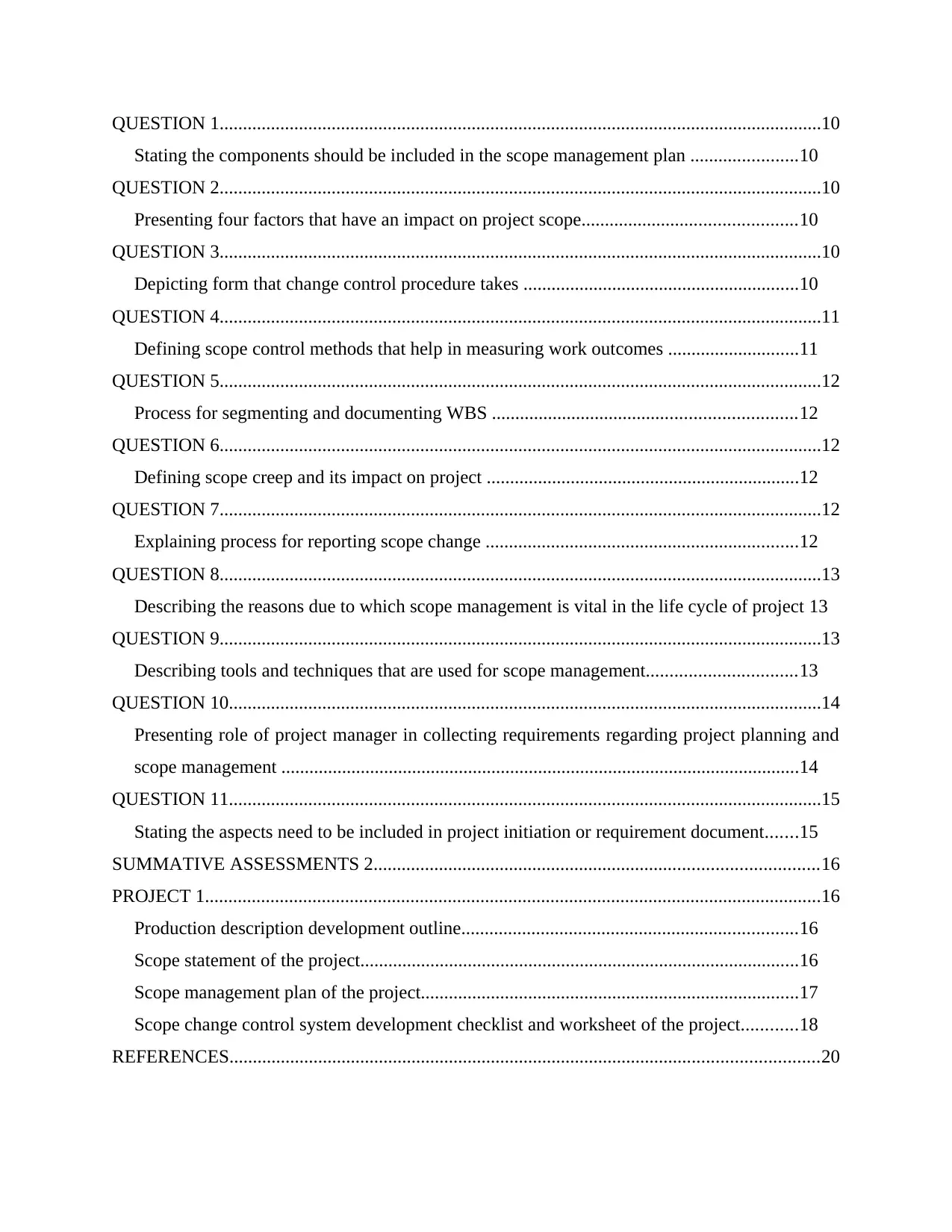
QUESTION 1.................................................................................................................................10
Stating the components should be included in the scope management plan .......................10
QUESTION 2.................................................................................................................................10
Presenting four factors that have an impact on project scope..............................................10
QUESTION 3.................................................................................................................................10
Depicting form that change control procedure takes ...........................................................10
QUESTION 4.................................................................................................................................11
Defining scope control methods that help in measuring work outcomes ............................11
QUESTION 5.................................................................................................................................12
Process for segmenting and documenting WBS .................................................................12
QUESTION 6.................................................................................................................................12
Defining scope creep and its impact on project ...................................................................12
QUESTION 7.................................................................................................................................12
Explaining process for reporting scope change ...................................................................12
QUESTION 8.................................................................................................................................13
Describing the reasons due to which scope management is vital in the life cycle of project 13
QUESTION 9.................................................................................................................................13
Describing tools and techniques that are used for scope management................................13
QUESTION 10...............................................................................................................................14
Presenting role of project manager in collecting requirements regarding project planning and
scope management ...............................................................................................................14
QUESTION 11...............................................................................................................................15
Stating the aspects need to be included in project initiation or requirement document.......15
SUMMATIVE ASSESSMENTS 2...............................................................................................16
PROJECT 1....................................................................................................................................16
Production description development outline........................................................................16
Scope statement of the project..............................................................................................16
Scope management plan of the project.................................................................................17
Scope change control system development checklist and worksheet of the project............18
REFERENCES..............................................................................................................................20
Stating the components should be included in the scope management plan .......................10
QUESTION 2.................................................................................................................................10
Presenting four factors that have an impact on project scope..............................................10
QUESTION 3.................................................................................................................................10
Depicting form that change control procedure takes ...........................................................10
QUESTION 4.................................................................................................................................11
Defining scope control methods that help in measuring work outcomes ............................11
QUESTION 5.................................................................................................................................12
Process for segmenting and documenting WBS .................................................................12
QUESTION 6.................................................................................................................................12
Defining scope creep and its impact on project ...................................................................12
QUESTION 7.................................................................................................................................12
Explaining process for reporting scope change ...................................................................12
QUESTION 8.................................................................................................................................13
Describing the reasons due to which scope management is vital in the life cycle of project 13
QUESTION 9.................................................................................................................................13
Describing tools and techniques that are used for scope management................................13
QUESTION 10...............................................................................................................................14
Presenting role of project manager in collecting requirements regarding project planning and
scope management ...............................................................................................................14
QUESTION 11...............................................................................................................................15
Stating the aspects need to be included in project initiation or requirement document.......15
SUMMATIVE ASSESSMENTS 2...............................................................................................16
PROJECT 1....................................................................................................................................16
Production description development outline........................................................................16
Scope statement of the project..............................................................................................16
Scope management plan of the project.................................................................................17
Scope change control system development checklist and worksheet of the project............18
REFERENCES..............................................................................................................................20
⊘ This is a preview!⊘
Do you want full access?
Subscribe today to unlock all pages.

Trusted by 1+ million students worldwide
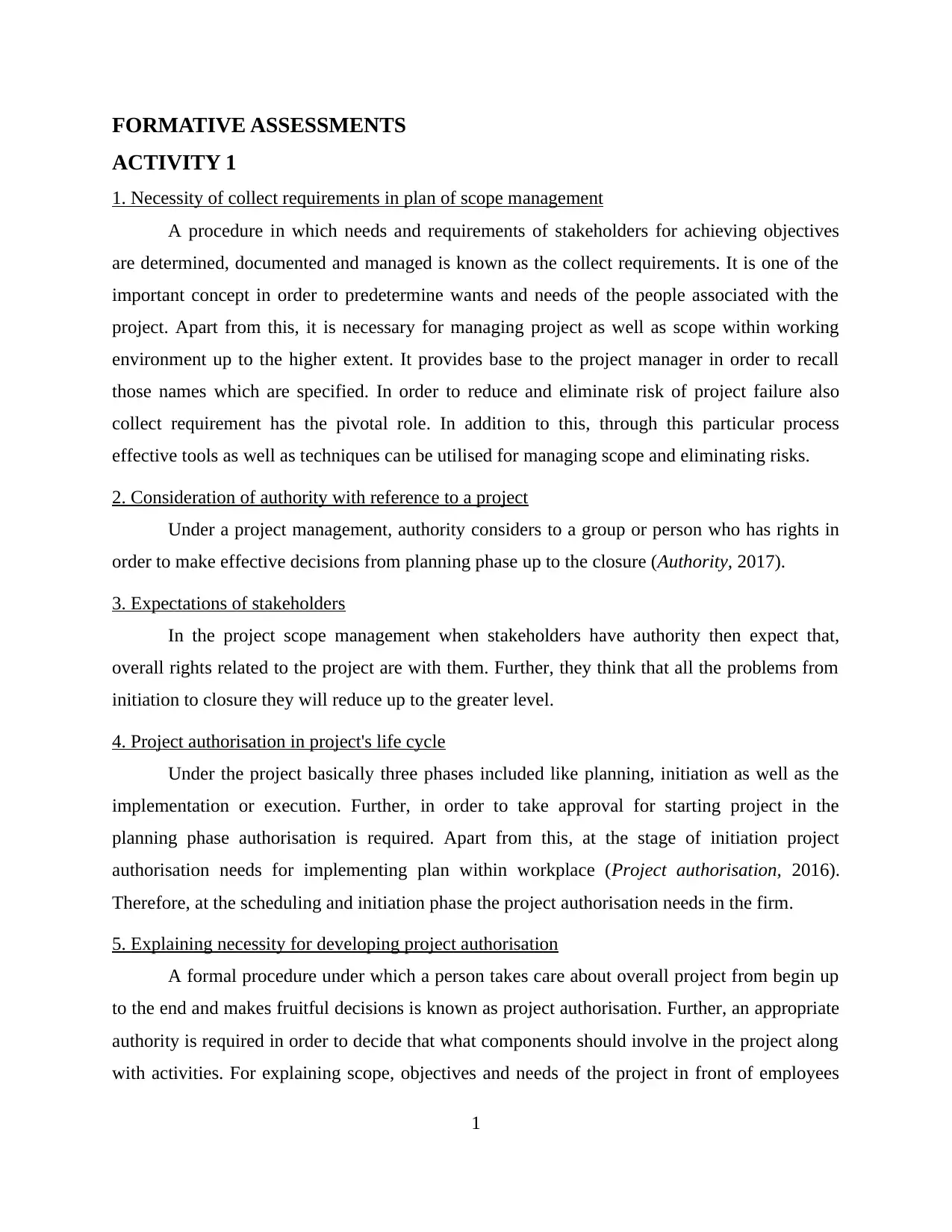
FORMATIVE ASSESSMENTS
ACTIVITY 1
1. Necessity of collect requirements in plan of scope management
A procedure in which needs and requirements of stakeholders for achieving objectives
are determined, documented and managed is known as the collect requirements. It is one of the
important concept in order to predetermine wants and needs of the people associated with the
project. Apart from this, it is necessary for managing project as well as scope within working
environment up to the higher extent. It provides base to the project manager in order to recall
those names which are specified. In order to reduce and eliminate risk of project failure also
collect requirement has the pivotal role. In addition to this, through this particular process
effective tools as well as techniques can be utilised for managing scope and eliminating risks.
2. Consideration of authority with reference to a project
Under a project management, authority considers to a group or person who has rights in
order to make effective decisions from planning phase up to the closure (Authority, 2017).
3. Expectations of stakeholders
In the project scope management when stakeholders have authority then expect that,
overall rights related to the project are with them. Further, they think that all the problems from
initiation to closure they will reduce up to the greater level.
4. Project authorisation in project's life cycle
Under the project basically three phases included like planning, initiation as well as the
implementation or execution. Further, in order to take approval for starting project in the
planning phase authorisation is required. Apart from this, at the stage of initiation project
authorisation needs for implementing plan within workplace (Project authorisation, 2016).
Therefore, at the scheduling and initiation phase the project authorisation needs in the firm.
5. Explaining necessity for developing project authorisation
A formal procedure under which a person takes care about overall project from begin up
to the end and makes fruitful decisions is known as project authorisation. Further, an appropriate
authority is required in order to decide that what components should involve in the project along
with activities. For explaining scope, objectives and needs of the project in front of employees
1
ACTIVITY 1
1. Necessity of collect requirements in plan of scope management
A procedure in which needs and requirements of stakeholders for achieving objectives
are determined, documented and managed is known as the collect requirements. It is one of the
important concept in order to predetermine wants and needs of the people associated with the
project. Apart from this, it is necessary for managing project as well as scope within working
environment up to the higher extent. It provides base to the project manager in order to recall
those names which are specified. In order to reduce and eliminate risk of project failure also
collect requirement has the pivotal role. In addition to this, through this particular process
effective tools as well as techniques can be utilised for managing scope and eliminating risks.
2. Consideration of authority with reference to a project
Under a project management, authority considers to a group or person who has rights in
order to make effective decisions from planning phase up to the closure (Authority, 2017).
3. Expectations of stakeholders
In the project scope management when stakeholders have authority then expect that,
overall rights related to the project are with them. Further, they think that all the problems from
initiation to closure they will reduce up to the greater level.
4. Project authorisation in project's life cycle
Under the project basically three phases included like planning, initiation as well as the
implementation or execution. Further, in order to take approval for starting project in the
planning phase authorisation is required. Apart from this, at the stage of initiation project
authorisation needs for implementing plan within workplace (Project authorisation, 2016).
Therefore, at the scheduling and initiation phase the project authorisation needs in the firm.
5. Explaining necessity for developing project authorisation
A formal procedure under which a person takes care about overall project from begin up
to the end and makes fruitful decisions is known as project authorisation. Further, an appropriate
authority is required in order to decide that what components should involve in the project along
with activities. For explaining scope, objectives and needs of the project in front of employees
1
Paraphrase This Document
Need a fresh take? Get an instant paraphrase of this document with our AI Paraphraser
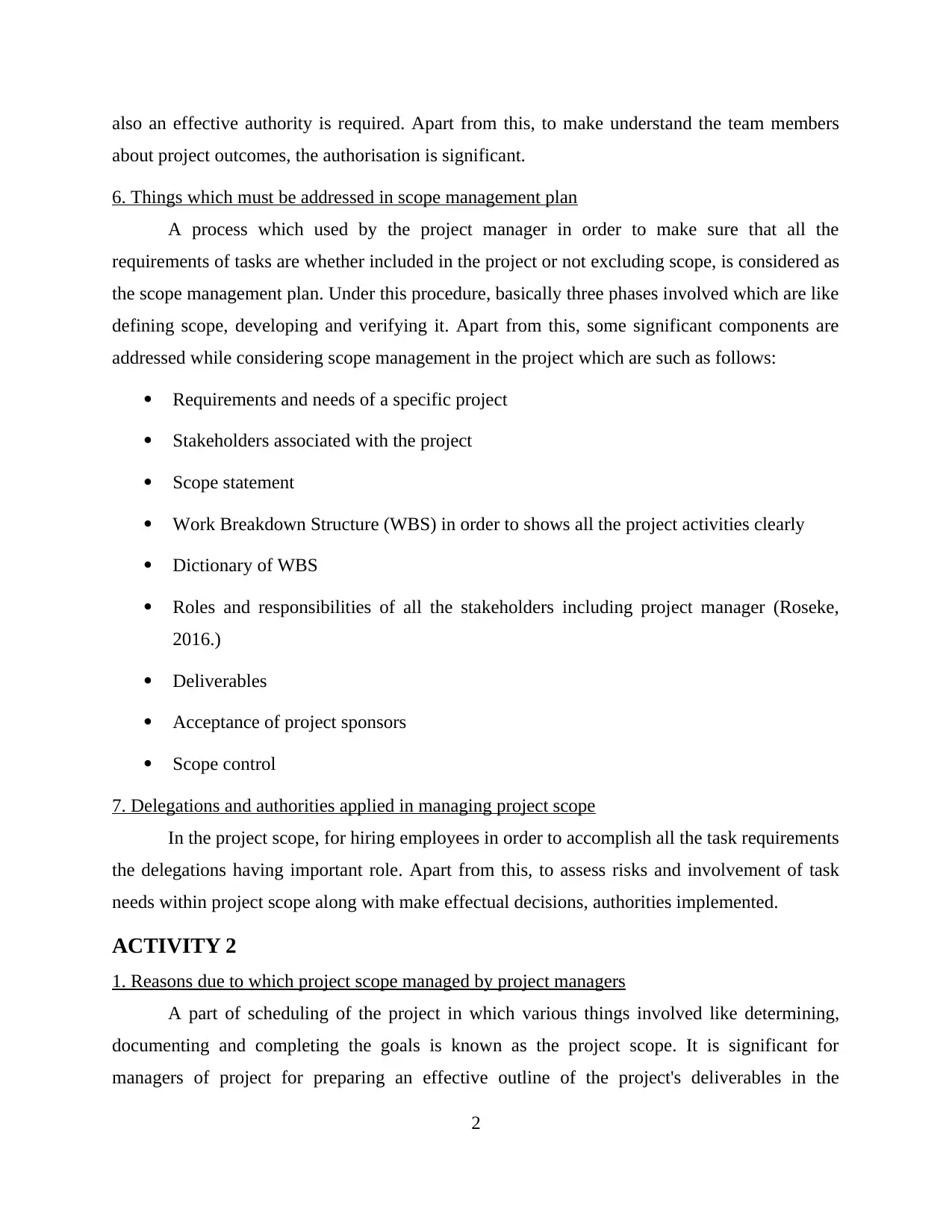
also an effective authority is required. Apart from this, to make understand the team members
about project outcomes, the authorisation is significant.
6. Things which must be addressed in scope management plan
A process which used by the project manager in order to make sure that all the
requirements of tasks are whether included in the project or not excluding scope, is considered as
the scope management plan. Under this procedure, basically three phases involved which are like
defining scope, developing and verifying it. Apart from this, some significant components are
addressed while considering scope management in the project which are such as follows:
Requirements and needs of a specific project
Stakeholders associated with the project
Scope statement
Work Breakdown Structure (WBS) in order to shows all the project activities clearly
Dictionary of WBS
Roles and responsibilities of all the stakeholders including project manager (Roseke,
2016.)
Deliverables
Acceptance of project sponsors
Scope control
7. Delegations and authorities applied in managing project scope
In the project scope, for hiring employees in order to accomplish all the task requirements
the delegations having important role. Apart from this, to assess risks and involvement of task
needs within project scope along with make effectual decisions, authorities implemented.
ACTIVITY 2
1. Reasons due to which project scope managed by project managers
A part of scheduling of the project in which various things involved like determining,
documenting and completing the goals is known as the project scope. It is significant for
managers of project for preparing an effective outline of the project's deliverables in the
2
about project outcomes, the authorisation is significant.
6. Things which must be addressed in scope management plan
A process which used by the project manager in order to make sure that all the
requirements of tasks are whether included in the project or not excluding scope, is considered as
the scope management plan. Under this procedure, basically three phases involved which are like
defining scope, developing and verifying it. Apart from this, some significant components are
addressed while considering scope management in the project which are such as follows:
Requirements and needs of a specific project
Stakeholders associated with the project
Scope statement
Work Breakdown Structure (WBS) in order to shows all the project activities clearly
Dictionary of WBS
Roles and responsibilities of all the stakeholders including project manager (Roseke,
2016.)
Deliverables
Acceptance of project sponsors
Scope control
7. Delegations and authorities applied in managing project scope
In the project scope, for hiring employees in order to accomplish all the task requirements
the delegations having important role. Apart from this, to assess risks and involvement of task
needs within project scope along with make effectual decisions, authorities implemented.
ACTIVITY 2
1. Reasons due to which project scope managed by project managers
A part of scheduling of the project in which various things involved like determining,
documenting and completing the goals is known as the project scope. It is significant for
managers of project for preparing an effective outline of the project's deliverables in the
2
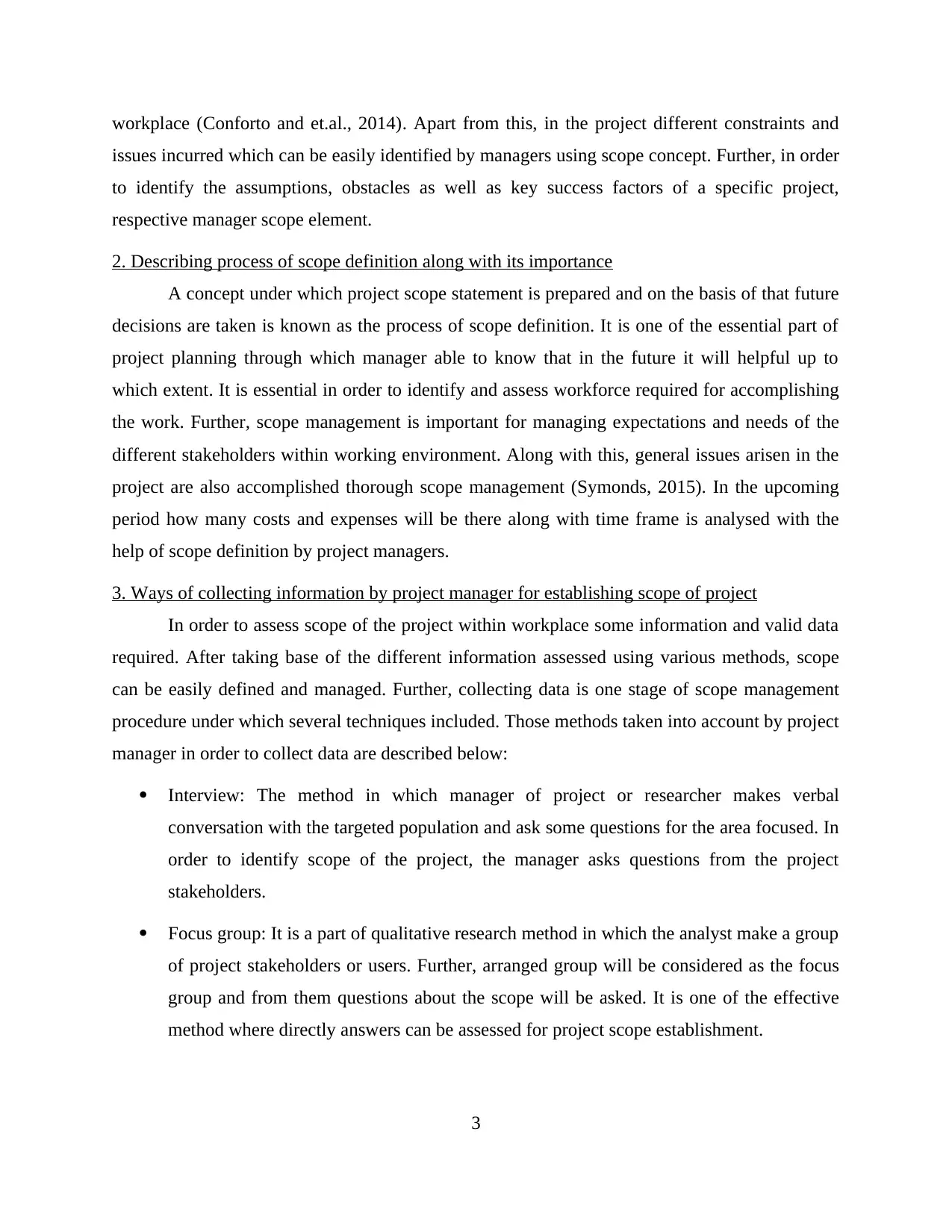
workplace (Conforto and et.al., 2014). Apart from this, in the project different constraints and
issues incurred which can be easily identified by managers using scope concept. Further, in order
to identify the assumptions, obstacles as well as key success factors of a specific project,
respective manager scope element.
2. Describing process of scope definition along with its importance
A concept under which project scope statement is prepared and on the basis of that future
decisions are taken is known as the process of scope definition. It is one of the essential part of
project planning through which manager able to know that in the future it will helpful up to
which extent. It is essential in order to identify and assess workforce required for accomplishing
the work. Further, scope management is important for managing expectations and needs of the
different stakeholders within working environment. Along with this, general issues arisen in the
project are also accomplished thorough scope management (Symonds, 2015). In the upcoming
period how many costs and expenses will be there along with time frame is analysed with the
help of scope definition by project managers.
3. Ways of collecting information by project manager for establishing scope of project
In order to assess scope of the project within workplace some information and valid data
required. After taking base of the different information assessed using various methods, scope
can be easily defined and managed. Further, collecting data is one stage of scope management
procedure under which several techniques included. Those methods taken into account by project
manager in order to collect data are described below:
Interview: The method in which manager of project or researcher makes verbal
conversation with the targeted population and ask some questions for the area focused. In
order to identify scope of the project, the manager asks questions from the project
stakeholders.
Focus group: It is a part of qualitative research method in which the analyst make a group
of project stakeholders or users. Further, arranged group will be considered as the focus
group and from them questions about the scope will be asked. It is one of the effective
method where directly answers can be assessed for project scope establishment.
3
issues incurred which can be easily identified by managers using scope concept. Further, in order
to identify the assumptions, obstacles as well as key success factors of a specific project,
respective manager scope element.
2. Describing process of scope definition along with its importance
A concept under which project scope statement is prepared and on the basis of that future
decisions are taken is known as the process of scope definition. It is one of the essential part of
project planning through which manager able to know that in the future it will helpful up to
which extent. It is essential in order to identify and assess workforce required for accomplishing
the work. Further, scope management is important for managing expectations and needs of the
different stakeholders within working environment. Along with this, general issues arisen in the
project are also accomplished thorough scope management (Symonds, 2015). In the upcoming
period how many costs and expenses will be there along with time frame is analysed with the
help of scope definition by project managers.
3. Ways of collecting information by project manager for establishing scope of project
In order to assess scope of the project within workplace some information and valid data
required. After taking base of the different information assessed using various methods, scope
can be easily defined and managed. Further, collecting data is one stage of scope management
procedure under which several techniques included. Those methods taken into account by project
manager in order to collect data are described below:
Interview: The method in which manager of project or researcher makes verbal
conversation with the targeted population and ask some questions for the area focused. In
order to identify scope of the project, the manager asks questions from the project
stakeholders.
Focus group: It is a part of qualitative research method in which the analyst make a group
of project stakeholders or users. Further, arranged group will be considered as the focus
group and from them questions about the scope will be asked. It is one of the effective
method where directly answers can be assessed for project scope establishment.
3
⊘ This is a preview!⊘
Do you want full access?
Subscribe today to unlock all pages.

Trusted by 1+ million students worldwide
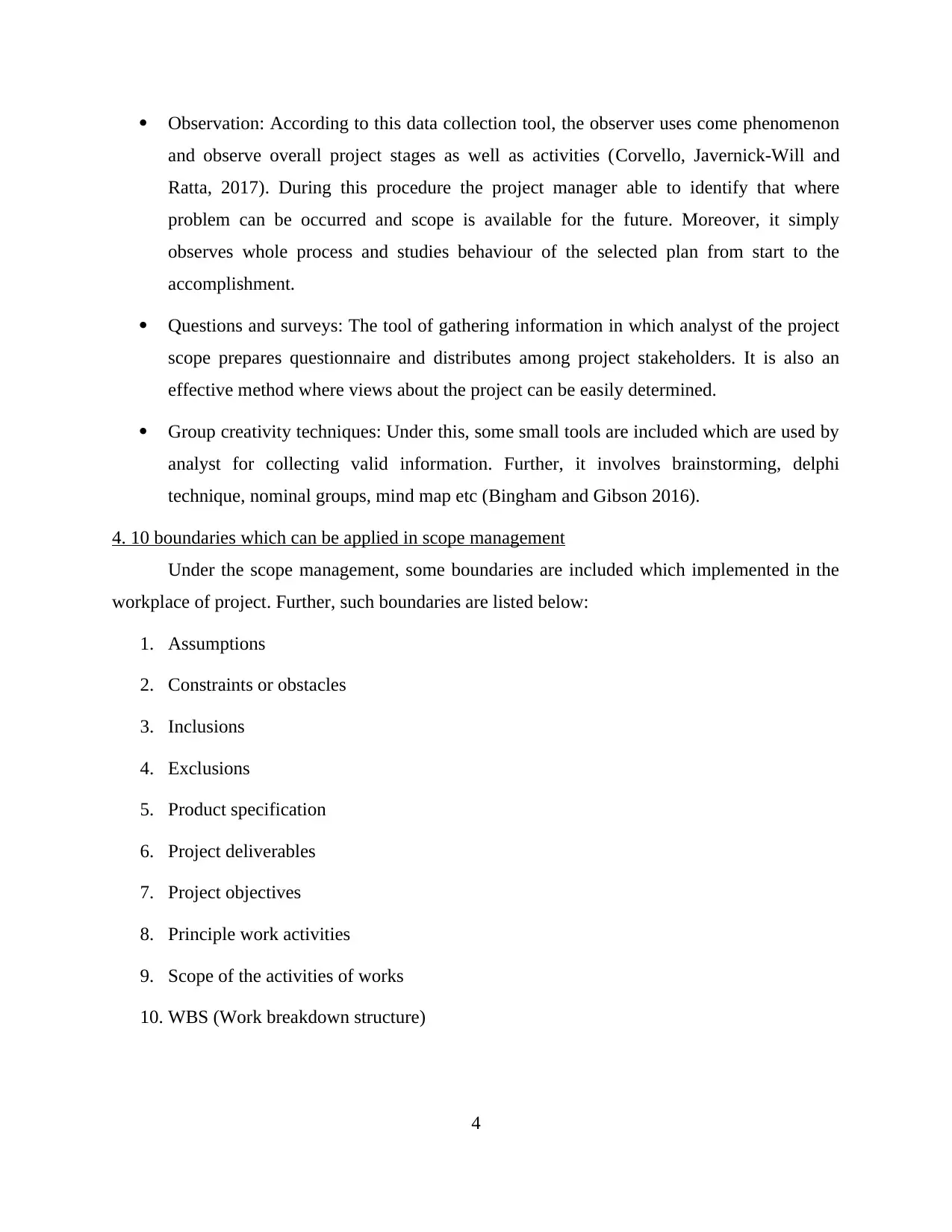
Observation: According to this data collection tool, the observer uses come phenomenon
and observe overall project stages as well as activities (Corvello, Javernick-Will and
Ratta, 2017). During this procedure the project manager able to identify that where
problem can be occurred and scope is available for the future. Moreover, it simply
observes whole process and studies behaviour of the selected plan from start to the
accomplishment.
Questions and surveys: The tool of gathering information in which analyst of the project
scope prepares questionnaire and distributes among project stakeholders. It is also an
effective method where views about the project can be easily determined.
Group creativity techniques: Under this, some small tools are included which are used by
analyst for collecting valid information. Further, it involves brainstorming, delphi
technique, nominal groups, mind map etc (Bingham and Gibson 2016).
4. 10 boundaries which can be applied in scope management
Under the scope management, some boundaries are included which implemented in the
workplace of project. Further, such boundaries are listed below:
1. Assumptions
2. Constraints or obstacles
3. Inclusions
4. Exclusions
5. Product specification
6. Project deliverables
7. Project objectives
8. Principle work activities
9. Scope of the activities of works
10. WBS (Work breakdown structure)
4
and observe overall project stages as well as activities (Corvello, Javernick-Will and
Ratta, 2017). During this procedure the project manager able to identify that where
problem can be occurred and scope is available for the future. Moreover, it simply
observes whole process and studies behaviour of the selected plan from start to the
accomplishment.
Questions and surveys: The tool of gathering information in which analyst of the project
scope prepares questionnaire and distributes among project stakeholders. It is also an
effective method where views about the project can be easily determined.
Group creativity techniques: Under this, some small tools are included which are used by
analyst for collecting valid information. Further, it involves brainstorming, delphi
technique, nominal groups, mind map etc (Bingham and Gibson 2016).
4. 10 boundaries which can be applied in scope management
Under the scope management, some boundaries are included which implemented in the
workplace of project. Further, such boundaries are listed below:
1. Assumptions
2. Constraints or obstacles
3. Inclusions
4. Exclusions
5. Product specification
6. Project deliverables
7. Project objectives
8. Principle work activities
9. Scope of the activities of works
10. WBS (Work breakdown structure)
4
Paraphrase This Document
Need a fresh take? Get an instant paraphrase of this document with our AI Paraphraser
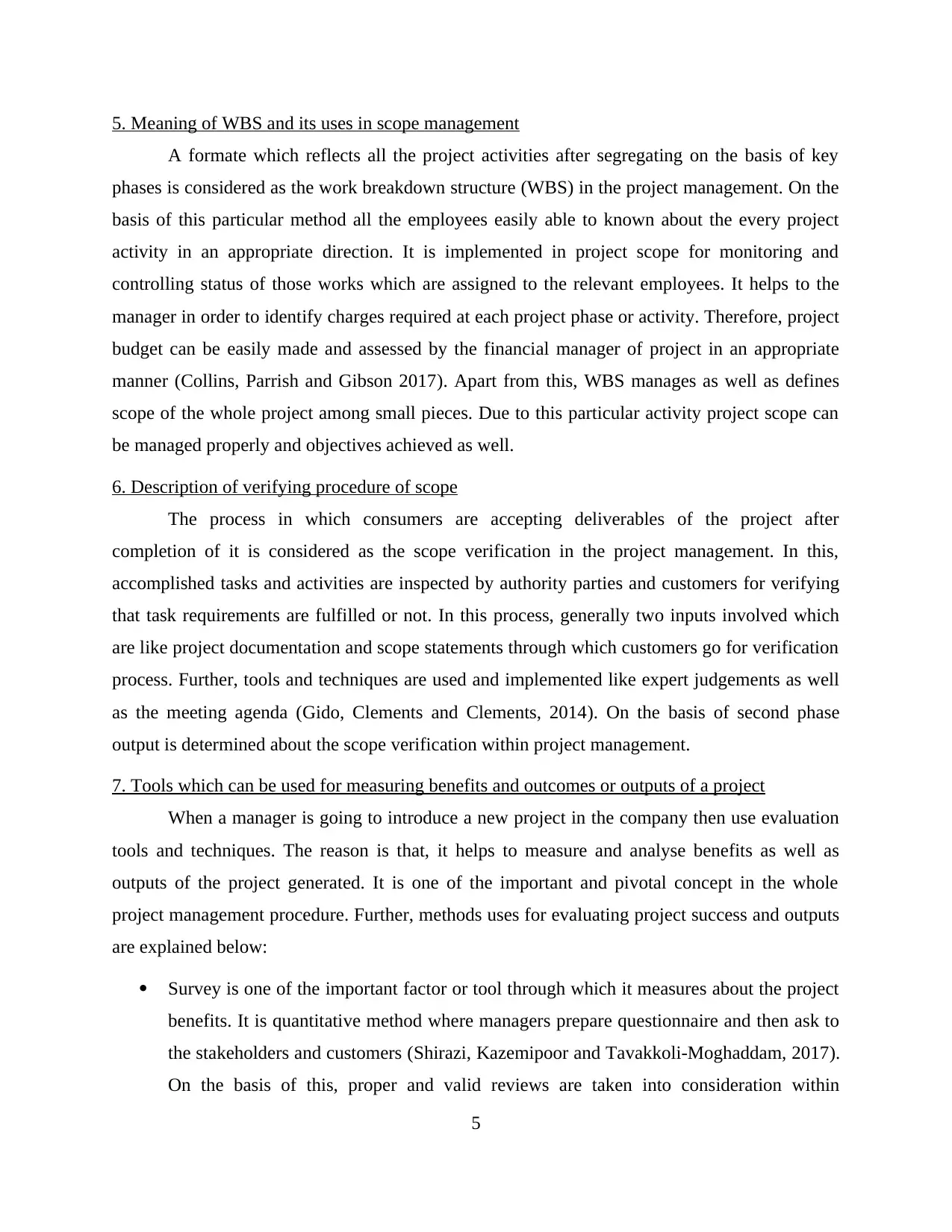
5. Meaning of WBS and its uses in scope management
A formate which reflects all the project activities after segregating on the basis of key
phases is considered as the work breakdown structure (WBS) in the project management. On the
basis of this particular method all the employees easily able to known about the every project
activity in an appropriate direction. It is implemented in project scope for monitoring and
controlling status of those works which are assigned to the relevant employees. It helps to the
manager in order to identify charges required at each project phase or activity. Therefore, project
budget can be easily made and assessed by the financial manager of project in an appropriate
manner (Collins, Parrish and Gibson 2017). Apart from this, WBS manages as well as defines
scope of the whole project among small pieces. Due to this particular activity project scope can
be managed properly and objectives achieved as well.
6. Description of verifying procedure of scope
The process in which consumers are accepting deliverables of the project after
completion of it is considered as the scope verification in the project management. In this,
accomplished tasks and activities are inspected by authority parties and customers for verifying
that task requirements are fulfilled or not. In this process, generally two inputs involved which
are like project documentation and scope statements through which customers go for verification
process. Further, tools and techniques are used and implemented like expert judgements as well
as the meeting agenda (Gido, Clements and Clements, 2014). On the basis of second phase
output is determined about the scope verification within project management.
7. Tools which can be used for measuring benefits and outcomes or outputs of a project
When a manager is going to introduce a new project in the company then use evaluation
tools and techniques. The reason is that, it helps to measure and analyse benefits as well as
outputs of the project generated. It is one of the important and pivotal concept in the whole
project management procedure. Further, methods uses for evaluating project success and outputs
are explained below:
Survey is one of the important factor or tool through which it measures about the project
benefits. It is quantitative method where managers prepare questionnaire and then ask to
the stakeholders and customers (Shirazi, Kazemipoor and Tavakkoli-Moghaddam, 2017).
On the basis of this, proper and valid reviews are taken into consideration within
5
A formate which reflects all the project activities after segregating on the basis of key
phases is considered as the work breakdown structure (WBS) in the project management. On the
basis of this particular method all the employees easily able to known about the every project
activity in an appropriate direction. It is implemented in project scope for monitoring and
controlling status of those works which are assigned to the relevant employees. It helps to the
manager in order to identify charges required at each project phase or activity. Therefore, project
budget can be easily made and assessed by the financial manager of project in an appropriate
manner (Collins, Parrish and Gibson 2017). Apart from this, WBS manages as well as defines
scope of the whole project among small pieces. Due to this particular activity project scope can
be managed properly and objectives achieved as well.
6. Description of verifying procedure of scope
The process in which consumers are accepting deliverables of the project after
completion of it is considered as the scope verification in the project management. In this,
accomplished tasks and activities are inspected by authority parties and customers for verifying
that task requirements are fulfilled or not. In this process, generally two inputs involved which
are like project documentation and scope statements through which customers go for verification
process. Further, tools and techniques are used and implemented like expert judgements as well
as the meeting agenda (Gido, Clements and Clements, 2014). On the basis of second phase
output is determined about the scope verification within project management.
7. Tools which can be used for measuring benefits and outcomes or outputs of a project
When a manager is going to introduce a new project in the company then use evaluation
tools and techniques. The reason is that, it helps to measure and analyse benefits as well as
outputs of the project generated. It is one of the important and pivotal concept in the whole
project management procedure. Further, methods uses for evaluating project success and outputs
are explained below:
Survey is one of the important factor or tool through which it measures about the project
benefits. It is quantitative method where managers prepare questionnaire and then ask to
the stakeholders and customers (Shirazi, Kazemipoor and Tavakkoli-Moghaddam, 2017).
On the basis of this, proper and valid reviews are taken into consideration within
5

workplace. When higher the stakeholders giving positive response to the surveyor then it
can be defined that project will give more benefits.
Another technique in order to assess outcomes of the project is observation where
manager or analyst observe whole phases and activities involved to accomplish the plan.
It is also one of the effectual tool where each and every activities of the whole project are
observed.
8. Listing out five project stakeholders
In the project different kinds of the stakeholders included among them basic five are
listed below:
1. Project managers
2. Resources managers
3. Peers or subordinates
4. Internal and external customers
5. Government
9. Project deliverables and ways through which communicated with stakeholders
A tangible as well as intangible products and services which are produced in the project
and delivers up to stakeholders in form of results is known as the project deliverables. Under the
project management deliverables can be in form of goods and services, milestones, software
products, training programmes, systems etc. In order to communicate various deliverables some
methods are considered like; project reports, online Gantt charts, Mind mapping software, face to
face, presentations and slides, newsletters, conference calls etc (Martinelli and Milosevic, 2016).
10. Ways for using scope verification
Scope verification is a framework in which acceptance about the scope in project is
formulated and finalised by different stakeholders. In order to identify desired or expected
outputs of the project which are associated with respective stakeholders this process is
undertaken by the manager or analyst. Further, basic three steps included in this which are stated
below:
6
can be defined that project will give more benefits.
Another technique in order to assess outcomes of the project is observation where
manager or analyst observe whole phases and activities involved to accomplish the plan.
It is also one of the effectual tool where each and every activities of the whole project are
observed.
8. Listing out five project stakeholders
In the project different kinds of the stakeholders included among them basic five are
listed below:
1. Project managers
2. Resources managers
3. Peers or subordinates
4. Internal and external customers
5. Government
9. Project deliverables and ways through which communicated with stakeholders
A tangible as well as intangible products and services which are produced in the project
and delivers up to stakeholders in form of results is known as the project deliverables. Under the
project management deliverables can be in form of goods and services, milestones, software
products, training programmes, systems etc. In order to communicate various deliverables some
methods are considered like; project reports, online Gantt charts, Mind mapping software, face to
face, presentations and slides, newsletters, conference calls etc (Martinelli and Milosevic, 2016).
10. Ways for using scope verification
Scope verification is a framework in which acceptance about the scope in project is
formulated and finalised by different stakeholders. In order to identify desired or expected
outputs of the project which are associated with respective stakeholders this process is
undertaken by the manager or analyst. Further, basic three steps included in this which are stated
below:
6
⊘ This is a preview!⊘
Do you want full access?
Subscribe today to unlock all pages.

Trusted by 1+ million students worldwide
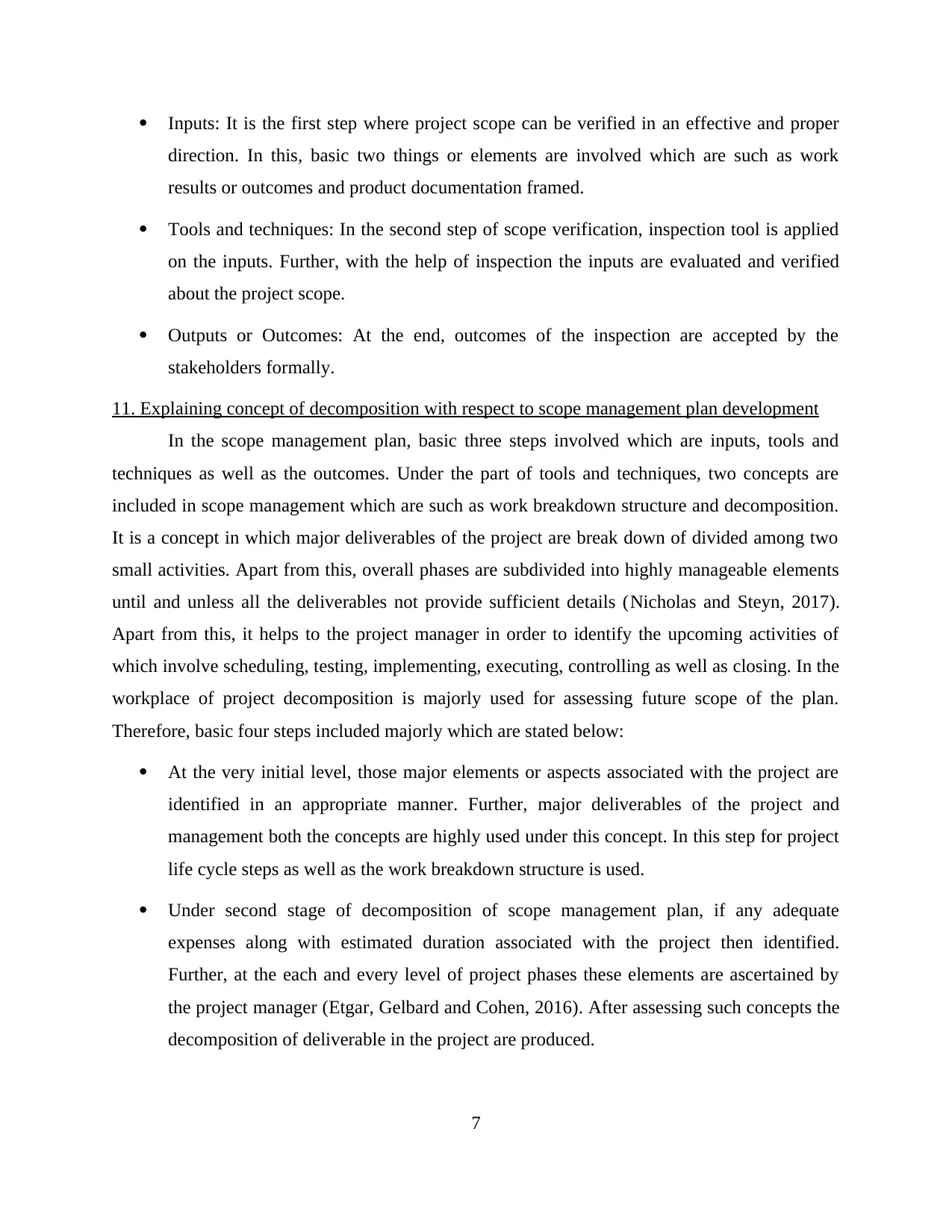
Inputs: It is the first step where project scope can be verified in an effective and proper
direction. In this, basic two things or elements are involved which are such as work
results or outcomes and product documentation framed.
Tools and techniques: In the second step of scope verification, inspection tool is applied
on the inputs. Further, with the help of inspection the inputs are evaluated and verified
about the project scope.
Outputs or Outcomes: At the end, outcomes of the inspection are accepted by the
stakeholders formally.
11. Explaining concept of decomposition with respect to scope management plan development
In the scope management plan, basic three steps involved which are inputs, tools and
techniques as well as the outcomes. Under the part of tools and techniques, two concepts are
included in scope management which are such as work breakdown structure and decomposition.
It is a concept in which major deliverables of the project are break down of divided among two
small activities. Apart from this, overall phases are subdivided into highly manageable elements
until and unless all the deliverables not provide sufficient details (Nicholas and Steyn, 2017).
Apart from this, it helps to the project manager in order to identify the upcoming activities of
which involve scheduling, testing, implementing, executing, controlling as well as closing. In the
workplace of project decomposition is majorly used for assessing future scope of the plan.
Therefore, basic four steps included majorly which are stated below:
At the very initial level, those major elements or aspects associated with the project are
identified in an appropriate manner. Further, major deliverables of the project and
management both the concepts are highly used under this concept. In this step for project
life cycle steps as well as the work breakdown structure is used.
Under second stage of decomposition of scope management plan, if any adequate
expenses along with estimated duration associated with the project then identified.
Further, at the each and every level of project phases these elements are ascertained by
the project manager (Etgar, Gelbard and Cohen, 2016). After assessing such concepts the
decomposition of deliverable in the project are produced.
7
direction. In this, basic two things or elements are involved which are such as work
results or outcomes and product documentation framed.
Tools and techniques: In the second step of scope verification, inspection tool is applied
on the inputs. Further, with the help of inspection the inputs are evaluated and verified
about the project scope.
Outputs or Outcomes: At the end, outcomes of the inspection are accepted by the
stakeholders formally.
11. Explaining concept of decomposition with respect to scope management plan development
In the scope management plan, basic three steps involved which are inputs, tools and
techniques as well as the outcomes. Under the part of tools and techniques, two concepts are
included in scope management which are such as work breakdown structure and decomposition.
It is a concept in which major deliverables of the project are break down of divided among two
small activities. Apart from this, overall phases are subdivided into highly manageable elements
until and unless all the deliverables not provide sufficient details (Nicholas and Steyn, 2017).
Apart from this, it helps to the project manager in order to identify the upcoming activities of
which involve scheduling, testing, implementing, executing, controlling as well as closing. In the
workplace of project decomposition is majorly used for assessing future scope of the plan.
Therefore, basic four steps included majorly which are stated below:
At the very initial level, those major elements or aspects associated with the project are
identified in an appropriate manner. Further, major deliverables of the project and
management both the concepts are highly used under this concept. In this step for project
life cycle steps as well as the work breakdown structure is used.
Under second stage of decomposition of scope management plan, if any adequate
expenses along with estimated duration associated with the project then identified.
Further, at the each and every level of project phases these elements are ascertained by
the project manager (Etgar, Gelbard and Cohen, 2016). After assessing such concepts the
decomposition of deliverable in the project are produced.
7
Paraphrase This Document
Need a fresh take? Get an instant paraphrase of this document with our AI Paraphraser
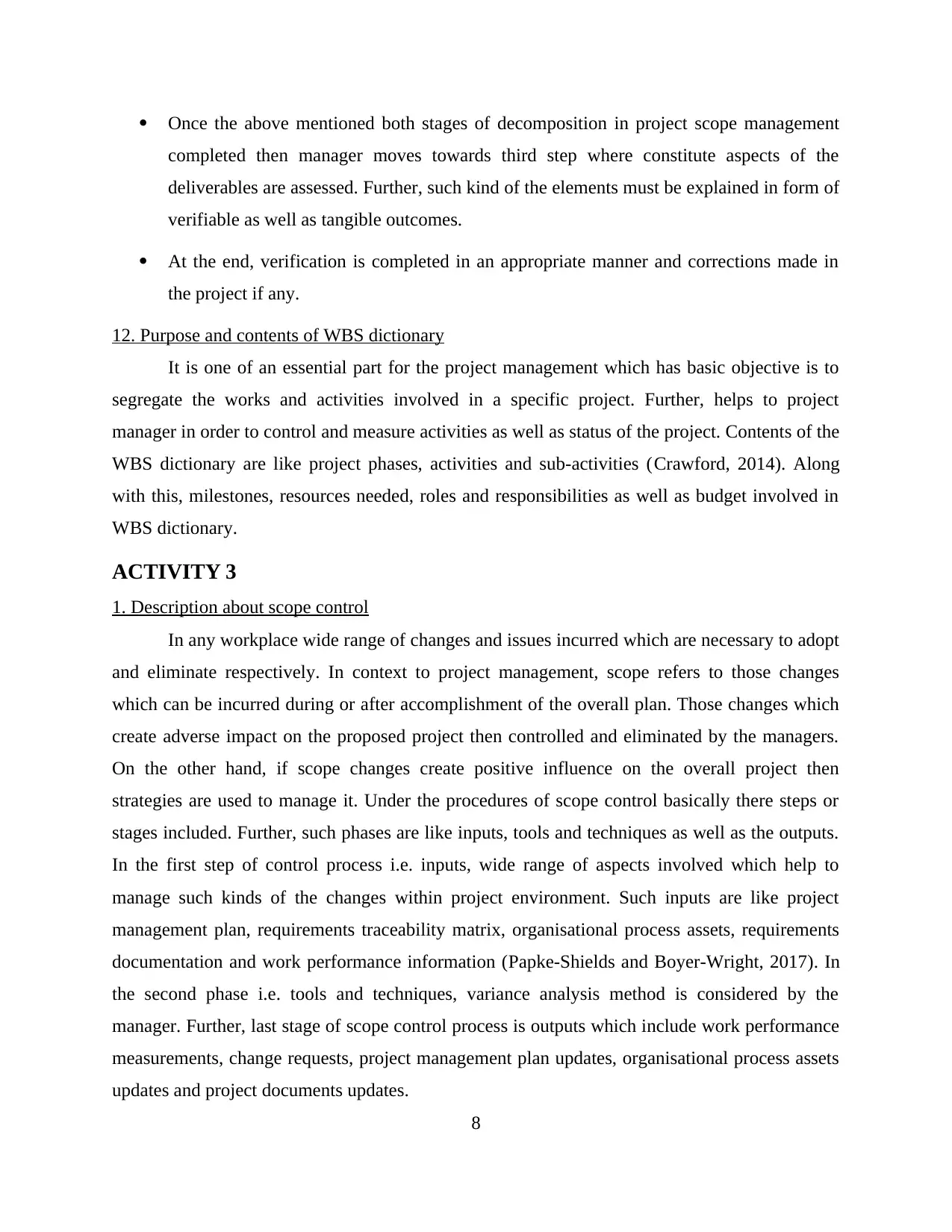
Once the above mentioned both stages of decomposition in project scope management
completed then manager moves towards third step where constitute aspects of the
deliverables are assessed. Further, such kind of the elements must be explained in form of
verifiable as well as tangible outcomes.
At the end, verification is completed in an appropriate manner and corrections made in
the project if any.
12. Purpose and contents of WBS dictionary
It is one of an essential part for the project management which has basic objective is to
segregate the works and activities involved in a specific project. Further, helps to project
manager in order to control and measure activities as well as status of the project. Contents of the
WBS dictionary are like project phases, activities and sub-activities (Crawford, 2014). Along
with this, milestones, resources needed, roles and responsibilities as well as budget involved in
WBS dictionary.
ACTIVITY 3
1. Description about scope control
In any workplace wide range of changes and issues incurred which are necessary to adopt
and eliminate respectively. In context to project management, scope refers to those changes
which can be incurred during or after accomplishment of the overall plan. Those changes which
create adverse impact on the proposed project then controlled and eliminated by the managers.
On the other hand, if scope changes create positive influence on the overall project then
strategies are used to manage it. Under the procedures of scope control basically there steps or
stages included. Further, such phases are like inputs, tools and techniques as well as the outputs.
In the first step of control process i.e. inputs, wide range of aspects involved which help to
manage such kinds of the changes within project environment. Such inputs are like project
management plan, requirements traceability matrix, organisational process assets, requirements
documentation and work performance information (Papke-Shields and Boyer-Wright, 2017). In
the second phase i.e. tools and techniques, variance analysis method is considered by the
manager. Further, last stage of scope control process is outputs which include work performance
measurements, change requests, project management plan updates, organisational process assets
updates and project documents updates.
8
completed then manager moves towards third step where constitute aspects of the
deliverables are assessed. Further, such kind of the elements must be explained in form of
verifiable as well as tangible outcomes.
At the end, verification is completed in an appropriate manner and corrections made in
the project if any.
12. Purpose and contents of WBS dictionary
It is one of an essential part for the project management which has basic objective is to
segregate the works and activities involved in a specific project. Further, helps to project
manager in order to control and measure activities as well as status of the project. Contents of the
WBS dictionary are like project phases, activities and sub-activities (Crawford, 2014). Along
with this, milestones, resources needed, roles and responsibilities as well as budget involved in
WBS dictionary.
ACTIVITY 3
1. Description about scope control
In any workplace wide range of changes and issues incurred which are necessary to adopt
and eliminate respectively. In context to project management, scope refers to those changes
which can be incurred during or after accomplishment of the overall plan. Those changes which
create adverse impact on the proposed project then controlled and eliminated by the managers.
On the other hand, if scope changes create positive influence on the overall project then
strategies are used to manage it. Under the procedures of scope control basically there steps or
stages included. Further, such phases are like inputs, tools and techniques as well as the outputs.
In the first step of control process i.e. inputs, wide range of aspects involved which help to
manage such kinds of the changes within project environment. Such inputs are like project
management plan, requirements traceability matrix, organisational process assets, requirements
documentation and work performance information (Papke-Shields and Boyer-Wright, 2017). In
the second phase i.e. tools and techniques, variance analysis method is considered by the
manager. Further, last stage of scope control process is outputs which include work performance
measurements, change requests, project management plan updates, organisational process assets
updates and project documents updates.
8
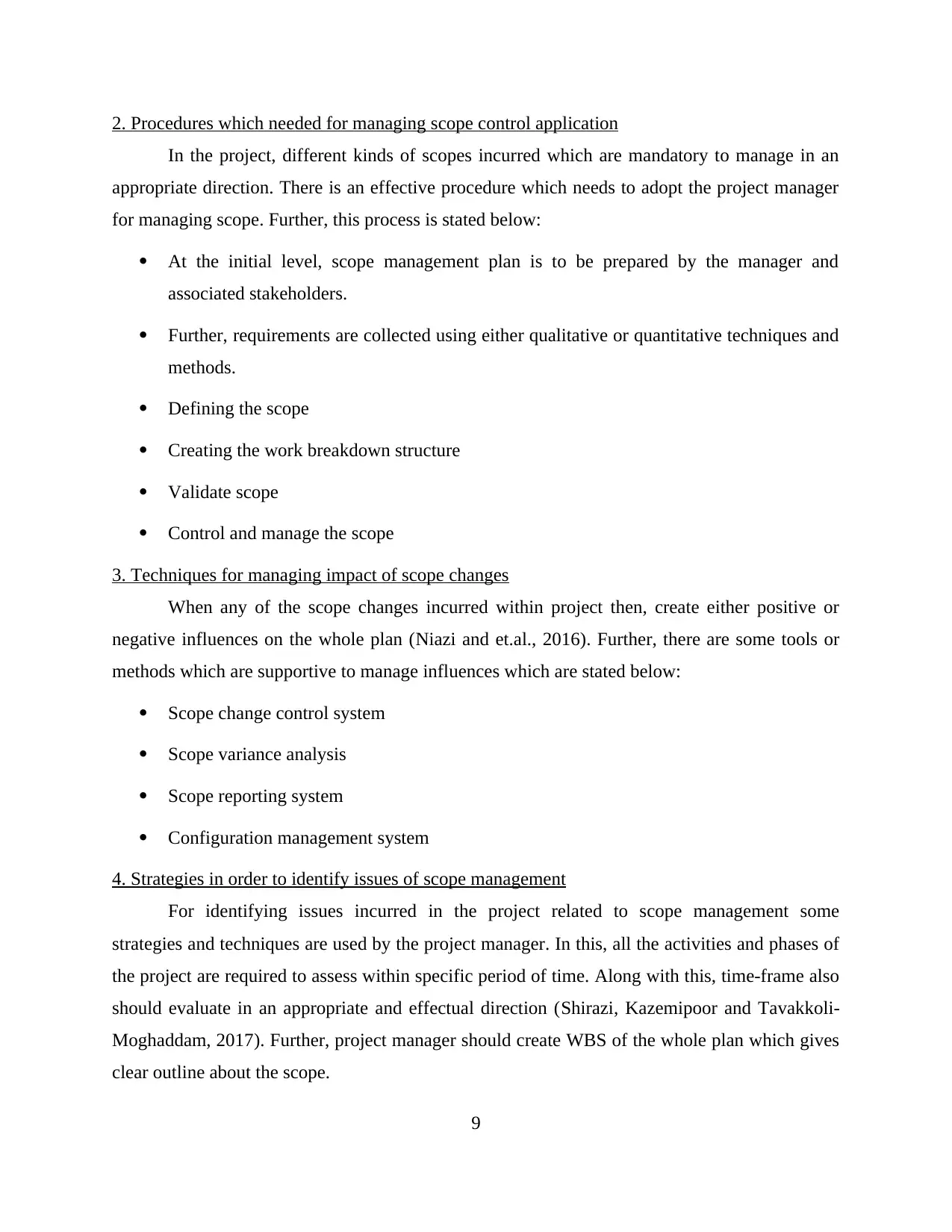
2. Procedures which needed for managing scope control application
In the project, different kinds of scopes incurred which are mandatory to manage in an
appropriate direction. There is an effective procedure which needs to adopt the project manager
for managing scope. Further, this process is stated below:
At the initial level, scope management plan is to be prepared by the manager and
associated stakeholders.
Further, requirements are collected using either qualitative or quantitative techniques and
methods.
Defining the scope
Creating the work breakdown structure
Validate scope
Control and manage the scope
3. Techniques for managing impact of scope changes
When any of the scope changes incurred within project then, create either positive or
negative influences on the whole plan (Niazi and et.al., 2016). Further, there are some tools or
methods which are supportive to manage influences which are stated below:
Scope change control system
Scope variance analysis
Scope reporting system
Configuration management system
4. Strategies in order to identify issues of scope management
For identifying issues incurred in the project related to scope management some
strategies and techniques are used by the project manager. In this, all the activities and phases of
the project are required to assess within specific period of time. Along with this, time-frame also
should evaluate in an appropriate and effectual direction (Shirazi, Kazemipoor and Tavakkoli-
Moghaddam, 2017). Further, project manager should create WBS of the whole plan which gives
clear outline about the scope.
9
In the project, different kinds of scopes incurred which are mandatory to manage in an
appropriate direction. There is an effective procedure which needs to adopt the project manager
for managing scope. Further, this process is stated below:
At the initial level, scope management plan is to be prepared by the manager and
associated stakeholders.
Further, requirements are collected using either qualitative or quantitative techniques and
methods.
Defining the scope
Creating the work breakdown structure
Validate scope
Control and manage the scope
3. Techniques for managing impact of scope changes
When any of the scope changes incurred within project then, create either positive or
negative influences on the whole plan (Niazi and et.al., 2016). Further, there are some tools or
methods which are supportive to manage influences which are stated below:
Scope change control system
Scope variance analysis
Scope reporting system
Configuration management system
4. Strategies in order to identify issues of scope management
For identifying issues incurred in the project related to scope management some
strategies and techniques are used by the project manager. In this, all the activities and phases of
the project are required to assess within specific period of time. Along with this, time-frame also
should evaluate in an appropriate and effectual direction (Shirazi, Kazemipoor and Tavakkoli-
Moghaddam, 2017). Further, project manager should create WBS of the whole plan which gives
clear outline about the scope.
9
⊘ This is a preview!⊘
Do you want full access?
Subscribe today to unlock all pages.

Trusted by 1+ million students worldwide
1 out of 25
Related Documents
Your All-in-One AI-Powered Toolkit for Academic Success.
+13062052269
info@desklib.com
Available 24*7 on WhatsApp / Email
![[object Object]](/_next/static/media/star-bottom.7253800d.svg)
Unlock your academic potential
Copyright © 2020–2025 A2Z Services. All Rights Reserved. Developed and managed by ZUCOL.




